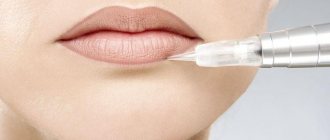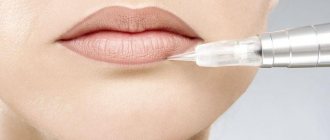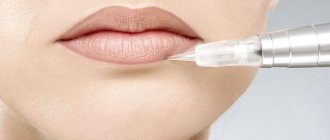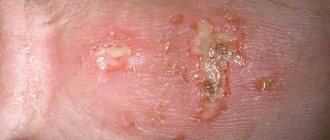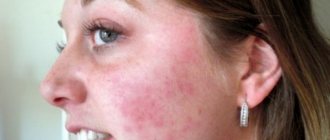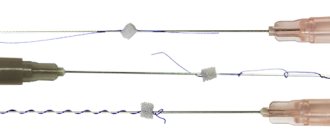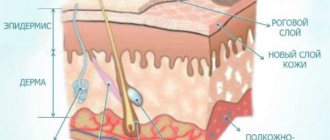Fordyce granules
Fordyce granules are hyperplastic sebaceous glands that tend to form in those areas of the body where the skin is thinnest and most delicate. Most often they are localized on the mucous membranes of the oral cavity (in particular on the cheeks), on the lips, in the groin, directly on the genitals and on the nipples. Such changes in the sebaceous glands were first described by the American dermatologist and syphilidologist John Addison Fordyce back in 1896. Hence the name that has now become generally accepted for them - Fordyce granules. Formations are considered one of the variants of the physiological norm, since they are: completely benign; do not harm health; are not accompanied by unpleasant symptoms; are not transmitted during sexual contact or any other way. That is why patients turn to specialized medical institutions only in cases where visible sebaceous glands represent a serious cosmetic defect and become a reason for a person’s dissatisfaction with their appearance. The exact reasons that provoke changes in the sebaceous glands have not been identified at the moment. However, most doctors, based on the results of pathomorphological studies of tissues, believe that the prerequisite for the occurrence of cysts are various types of congenital disorders of the development of the sebaceous glands, leading to their displacement into the upper layer of the skin or to a change in their normal location (the location of the sebaceous glands in the area of the border of the lips is considered abnormal , on the mucous membranes of the oral cavity, etc.). Another cause of Fordyce granules is considered to be hyperplasia of the excretory ducts of the sebaceous glands, which provokes the appearance of cystic formations in them. Simply put, Fordyce granules develop in people who have excessive narrowing or blockage of the excretory ducts of the glands, accompanied by the accumulation of secretions (sebum) in them. Sebaceous gland cysts first appear in humans during adolescence, when the process of puberty begins, that is, approximately in the range from 13 to 17 years. Thus, it can be assumed that the process of formation of Fordyce granules proceeds in accordance with the following algorithm: during the period of intrauterine development in the fetus, for one reason or another, the formation of the sebaceous glands is disrupted; when the child reaches a certain age, under the influence of steroid hormones that are produced by the sex glands (the so-called androgen hormones), the glands begin to increase in size and actively produce sebum, which results in their visualization.
Characteristic features of Fordyce granules. Externally, sebaceous gland cysts resemble small nodules (or papules) the size of a millet grain. As a rule, such rashes are numerous, widespread and not accompanied by pain (either at rest or when pressing on them). When pressing on the formation, in some cases a very small amount of liquid may be released from it, having a white-yellow tint and a rather thick consistency. However, more often than not, attempts to squeeze the contents out of Fordyce granules end in pinpoint bleeding and the development of hematomas in the area of skin surrounding the damaged papule.
Doctors are categorical in their prohibitions on self-removal of Fordyce granules, since this, firstly, is very painful, and secondly, provokes inflammatory processes and scarring of the skin. This is especially true in cases where the cysts are localized in the lip border area. Fordyce granules on the lips in the vast majority of cases (up to 90%) occur in women. This type of Fordyce granules occurs as a result of damage to the apocrine sweat glands, which are somewhat associated with the genitourinary system.
Treatment of Fordyce granules. Unfortunately, there are currently no effective methods for treating Fordyce granules. The use of jojoba oil and vitamin A is recommended as a means to inhibit further development of the process. These products help remove Fordyce granules that are already present and prevent the formation of new ones. Such drugs can act mainly on fresh cysts.
The main methods of removal are electrocoagulation or cryotherapy. Treatment of large Fordyce granules, as well as formations classified as old, is carried out through their surgical removal. The decision on the possible removal of certain elements is made by the attending physician. In this case, the skin over the papule is opened, the wen itself is peeled off, and the bleeding is stopped using an electrocoagulant. The edges of the operated area are sutured with special materials.
Pustovoitova E.V.
How is recovery and treatment going?
Fordyce granules and (permanent makeup can disguise seborrheic cysts, but not eliminate them) other imperfections on the lips will become less noticeable a month after tattooing. During this time, the skin will completely recover after the injection of pigment.
Recovery takes place in stages:
| Stage | Recovery Features |
| Post-traumatic period | In the first 2-3 days, redness and swelling of the lips will be noticeable. Damaged skin should be lubricated with De-Panthenol or other panthenol-based ointments 2-3 times a day. The lips will have a rich red color at this time, but it will become noticeably paler towards the end of the restoration process. |
| Intensive recovery | When the inflammation decreases, the skin will begin to peel off. The process usually lasts 2-3 weeks. At this stage, the lips continue to be smeared with restorative ointments 1-2 times a day. |
| Consolidate the result | When the crust is completely gone, you need to use hygienic moisturizing lipstick for a week. You should choose hypoallergenic cosmetics so as not to provoke re-inflammation and drying of the lips. |
Result before and after the procedure.
Diagnostics
To undergo a diagnostic examination, you must first visit a therapist . He will give referrals to doctors of narrow specialization: dermatologist, endocrinologist . Women will also need to be examined by a gynecologist to confirm or deny the causes of the rash.
If the number of granules is small - 2-5 pieces, then a specialist in most cases makes a diagnosis immediately after a visual examination. There is no need to take tests or undergo hardware diagnostics (except for controversial issues or doubts).
When the rashes are profuse, in addition to discomfort, there is also itching, then a detailed examination, tests and specific procedures are mandatory for making a diagnosis and starting treatment. Additional examination is carried out in order to exclude the possibility of medical error. It is easy to attribute the granules to manifestations of eczema, rashes of an allergic nature, neurodermatitis, or molluscum contagiosum.
The main method of examination is taking a skin sample from the damaged area (biopsy) . Additional tests (general blood and biochemical) may be required if the doctor suspects the development of lichen ruber. Also, tests are prescribed by specialized specialists (for hormones, examination of the thyroid gland) when there are suspicions or additional symptoms characteristic of the disease.
Important! Despite the abundance of rashes, the quantity or color of the granules does not pose a health hazard. The main disadvantage is the visual unaesthetic. The transformation of neoplasms into malignant types of tumors (cancer) has not been detected over all the years of observation and examination.
Can I cope on my own or should I consult a doctor?
You can get rid of the problem yourself if a person has knowledge in the field of cosmetology and dermatology. It is best not to try to get rid of the problem yourself , since symptoms may indicate the presence of specific problems in the body that require professional solutions and constant medical supervision.
You should not delay your consultation if there is obvious discomfort when talking or eating. The appearance of discharge or blood from the granules, increasing itching or pain also indicates the need for a medical examination.
Can they appear after lip augmentation?
In rare cases, granules may appear after a lip augmentation procedure . This is due to the fact that hyaluronic acid is used as the main component. The body reacts to its excess or presence. As a result, characteristic thickenings form on the lips.
Granules appearing after lip augmentation procedure
Is it possible to get a tattoo with this pathology?
Since cysts do not contain any infection, their presence is not a contraindication to tattooing (permanent makeup). A similar approach is used to visually hide a problem when treatment has not produced the desired results.
Tattooing will help hide the defect
Symptoms and external manifestations of pathology
In order to take measures to remove tumors, you need to know the symptoms of the problem. Under normal conditions, the sebaceous glands under the skin are not visible, but if the prerequisites are present, the granules become visually noticeable.
In addition, there are other symptoms :
- bulges appear;
- formations at the very beginning have a reddish tint, then change color to white or yellow;
- formations can be single or collected in groups;
- in 90% of cases there is no itching, but sometimes it may be present;
- discomfort appears in the damaged area;
- formations may be present in small quantities on the skin nearby (lower near the nose, on the chin);
- in rare cases (20-30%), swelling appears at the site of the rash and a burning sensation;
- lips become faintly pink, sometimes have a yellowish tint.
The formations are easily visible through the skin when stretched (smile, exercises for facial wrinkles). If one or more of these symptoms appear at the same time, it is recommended to consult a doctor, cosmetologist, or undergo examination by a dermatologist.
Attention! You should not try to squeeze out the granules, as there is a high probability of infection getting under the skin.
Possible complications
No significant changes in health status are observed. After the spots disappear, the situation can go in two ways:
- the condition of the skin will improve, as hormonal levels return to normal, the functioning of the sebaceous glands is stabilized;
- the condition will become worse than before the appearance of the granules. In most situations, this is due to age factors (the skin goes through the aging stage).
Doctors recommend not to resort to serious impacts on formations if they do not cause severe discomfort.
How do they look
Fordyce spots visually look like yellowish granules or swellings that are clearly visible on the lips.
The main area of their concentration is the area near the sebaceous ducts. They are located not on the surface, but under the skin. At their core, they are sebaceous formations that gradually accumulate and form something like a bubble or granule. They were first discovered and studied by dermatologist John Addison Fordis (a specialist from the USA). He was the first to give a detailed description of formations in medical literature.
The granules are similar in size to grains of rice. Most often, neoplasms appear in size about 1-3 mm. 1-2 pieces are formed or combined into a group of 20-30 papules. Clearly noticeable when smiling (stretching lips). They do not contain or spread bacteria or viruses. In medicine, the phenomenon is classified as a skin condition, but not a disease.
The main harm to a person is psychological discomfort . Research statistics show that the problem is present in 36% of women and 60% of men. The age when granules may first appear is 13-16 years. Age corresponds to a period when the body undergoes rapid changes in hormones.
